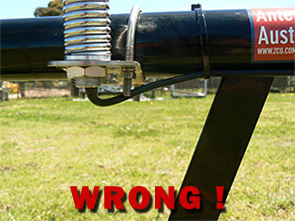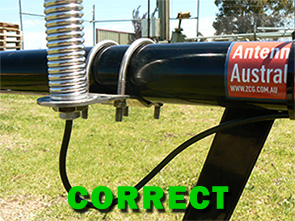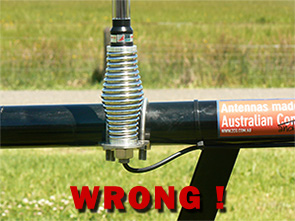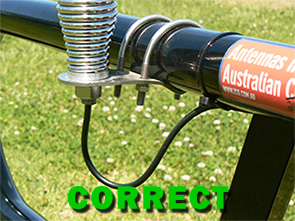To ensure the performance of your ZCG vehicle mount/mobile antenna is as stated, we provide the following important installation advice. The general principles explained here apply to our entire range of vehicle mount antennas including:
- AM/FM Radio Receive antennas.
- Cellular 5G/4G/3G Mobile Phone antennas.
- Satellite Communications Antennas.
- CB Radio UHF 477MHz antennas.
- VHF CB Radio 148-174MHz antennas.
- HF 27MHz Antennas.
ZCG supply an “Installation Guide” with every antenna.
Selecting the antenna mount position
Optimum antenna performance will be achieved by following these general principles :
- Mount the antenna in as high a place as possible.
- Mount the antenna as far away from other antennas and metallic objects as possible to avoid interference and distortion of the 360° omnidirectional radiation pattern – at minimum 350mm of side clearance is desirable, preferably more.
- Mount the antenna vertical, not at an angle.
Routing antenna coaxial cable.
When routing your coaxial cable, slack or excess cable at the point of exiting the antenna or spring base must be included, regardless whether the cable bottom exits or side exits from the mobile antenna.
Leaving a “stress relief loop” in the coaxial cable will permit the antenna to flex if contact with the antenna occurs without placing unnecessary tension on the cable.
Failure to follow this advice will most likely result in the coaxial cable being put under excessive tension and can cause the coaxial cable to become detached from the connection point! This issue is not covered under warranty.




Route the antenna feeder cable carefully
Route the antenna feeder cable carefully to your radio or mobile phone. A damaged feeder cable is a cause of high VSWR and reduced performance.
- Avoid high heat areas in the engine bay.
- Ensure that the cable is not under tension and there are no sharp kinks or sharp abrasion areas.
- Secure using cable ties, ensure enough tension to secure the cable is applied but do not over-tighten the cable tie as this will lead to deformation of the coaxial cable, resulting in a under performing or non-functioning system.
For high corrosion locations, we recommend using 316 stainless steel cable ties which offer significant service-life benefits over the black nylon type.
Fit the connector properly
To make installation simple and reduce system faults, many ZCG mobile antennas are supplied with the connector/termination already fitted and/or a compatible adaptor supplied. However, some of our range do not come terminated and require fitment of the connector once the antenna is installed and coaxial cable routed.
Our connector specification sheets include up-to-date coaxial cable strip instructions to ensure correct fitment of terminations/connectors.
For additional assistance please contact us directly.
How to field tune a mobile antenna
A large percentage of our mobile antennas come pre-tuned from our manufacturing facility and do not require ‘in-field’ tuning. For our range of ‘field-tune’ antennas the antenna must firstly be installed into the required location and a network analyser or SWR meter should be used (multi-meters are not suitable) and the following procedures should be undertaken :
- IMPORTANT: Secure the antenna in the intended final position before commencing the field tune process. This is important since the mounting location will affect the tuning capability.
- Connect the antenna to your network analyser or SWR meter and the meter to your radio. (Multi-meters are not suitable)
- Set the correct frequency range and power band on the network analyser or SWR meter.
- Tune your radio to the desired centre frequency.
- Press and hold the transmit button on the microphone of your radio and check the SWR reading on the meter.
- If SWR is greater than 1.5:1, loosen the grub screw in the antenna ferrule holding the stainless steel whip to the point where you can remove the whip. For a fibreglass whip, remove the top cap.
- For a stainless steel whip, trim a short 2mm length from the bottom of the whip. Insert the whip back into the ferrule and secure with the grub screw.
For a fibreglass whip, trim 2mm from the top of the whip. Then replace the top cap.
It is important to trim only short lengths gradually. - Repeat step 5 and check the SWR reading of the meter again.
- Repeat steps 5-7 trimming process very gradually until SWR reduces to less than 1.5:1 at the desired centre frequency.
- Finally, for a stainless steel whip, tighten the grub screw to firmly secure the whip, thread-locker can be applied. For a fibreglass whip, replace the top cap, adhesive bonding glue can be applied.
- Disconnect the SWR meter and attach the feeder cable to your radio.
- Ensure all terminations are secure and adequate waterproofing is applied to ensure no water/dust ingression.
The field tune process is now complete.
We recommend a yearly inspection and ‘tune-check’ on all mobile vehicle mount systems to ensure performance of your systems is maintained.


